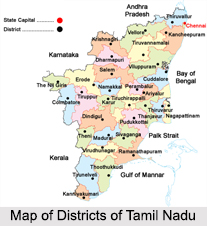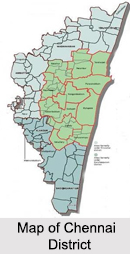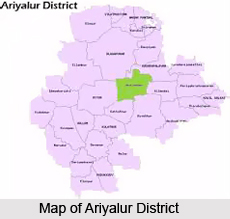 Tamil Nadu is amongst the 28 states of India and is the 11th state in the country and ranked 7th in terms of population. Tamil Nadu occupies the extreme south of the Indian peninsula and has a rich cultural heritage. Bharatnatyam and Carnatic Music have flourished here for centuries. The state is also famous for its handicrafts made of wood, stone and metal. This state is also the source of forest products like sandalwood, timber, fuel-wood and crops like, sugarcane, groundnut, potatoes and spices. Currently, there are about 32 districts in Tamil Nadu, which are elaborately discussed below.
Tamil Nadu is amongst the 28 states of India and is the 11th state in the country and ranked 7th in terms of population. Tamil Nadu occupies the extreme south of the Indian peninsula and has a rich cultural heritage. Bharatnatyam and Carnatic Music have flourished here for centuries. The state is also famous for its handicrafts made of wood, stone and metal. This state is also the source of forest products like sandalwood, timber, fuel-wood and crops like, sugarcane, groundnut, potatoes and spices. Currently, there are about 32 districts in Tamil Nadu, which are elaborately discussed below.
Chennai District: Formerly known as Madras District, this is the smallest of all the districts of Tamil Nadu, but has the highest human density. The Chennai District is a city district which means that it does not have district headquarters. Expansion of this district took place in April, 2018 and is now aligned with the Greater Chennai Corporation boundary.
Cuddalore District: One of the districts of Tamil Nadu, the Cuddalore District used to be an old seaport in the ancient days. Currently the district comprises of 10 taluks, 13 blocks, 5 municipalities, and 18 town panchayats.
Kancheepuram District: Came into existence in 1997, the Kancheepuram District is known for its silk sarees and weaving. The main occupation in the district is agriculture which contributes to the economy of the state.
 Tiruvallur District:
Tiruvallur District:
Out of all the districts of Tamil Nadu, the Tiruvallur District
is known to be the administrative district in South India. With a mixture of urban and rural characteristics, Tiruvallur is one of the fastest growing districts of Tamil Nadu in terms of industrial development.
Tiruvannamalai District: The district of Tiruvannamalai is known for its two major businesses- agriculture and silk saree weaving. The cultivation of rice is another of the highest grossing business in the district.
Vellore District: Known to be one of the biggest districts of Tamil Nadu, the Vellore District is primarily agrarian with a majority of its population involved in agriculture. The district of Vellore is one of the top producers of sugarcane and coconut in the state.
Viluppuram District: Out of all the districts of Tamil Nadu, the Viluppuram District is the largest. The district is known for its ancient temples, mosques and churches which also serves as great tourist attraction.
Ariyalur District: The famous Brihadeeswara Temple of Gangaikonda Cholapuram is situated in the Ariyalur District and serves as a popular tourist attraction. The district is noted for its cement industries and huge reserves of lignite. Other than these, the Ariyalur District is also known for its rich pre-historic fossils.
Nagapattinam District: One of the coastal districts of Tamil Nadu, the Nagapattinam District was carved out by bi-furcating the erstwhile composite Thanjavur district in the year 1991. With a rich cultural heritage, the district also has popular tourist sites.
Perambalur District: The Perambalur district is a centrally located inland district of Tamil Nadu and is currently known to be the top producer of maize and onions in the state.
Thanjavur District: Mostly agrarian with fertile lands, the Thanjavur District is situated in the delta of the Cauvery River. Known as the "Rice Bowl of Tamil Nadu", out of all the other districts of Tamil Nadu, Thanjavur is the main producer of rice in the state.
 Tiruchirapalli District: The Tiruchirapalli District has a large cattle and poultry population with agricultural workers in the smaller villages and thus boosts the economy of the district.
Tiruchirapalli District: The Tiruchirapalli District has a large cattle and poultry population with agricultural workers in the smaller villages and thus boosts the economy of the district.
Karur District: The economy of Karur District is based on agriculture, home textiles, production of paper using bagasse, and industries like cement, sugar, etc. The district also has several places of interest which serves as perfect picnic spots.
Tiruvarur District: The Thiruvarur district, along with the Nagapattinam district was part of the Thanjavur District before 1991. The present Thiruvarur district was formed in 1997 by trifurcating the then Thanjavur District.
Dharmapuri District: One of the first districts of Tamil Nadu created after the Independence of India, the Dharmapuri District is currently one of the major producers of mango in the state. Dharmapuri also produces fine quality granite in the district and is one of the main sericulture or silk farming belts in the state.
Krishnagiri District: Out of all the districts of Tamil Nadu, the Krishnagiri District is one of the largest producers of mangoes in India. In Tamil Nadu, e-Governance was first introduced in the Krishnagiri District under the National e-Governance Project (NEGP) in revenue and social welfare departments on a pilot basis.
Namakkal District: Often referred to as the "Egg City" or the "Transport City", the Namakkal District is famous for its large poultry industry, egg production and lorry body-building industry.
Salem District: Earlier, Salem was the biggest district before separating from Dharmapuri and used to be one of the largest districts of Tamil Nadu. Currently, the district has several industries like the handloom industry and a large number of Sago industries in the state. There are also several steel plants and aluminium companies which boosts the economy of the district.
Erode District: The district has a number of Power-Loom Textile Industries. The other major industries of the Erode District are screen printing and vanaspati manufacturing.
Tiruppur District: The district of Tiruppur is well-developed and industrialized. The Tiruppur banian industry, the cotton market, kangeyam bull and the famous uthukklui butter, among other things, provide for a vibrant economy.
Coimbatore District: One of the most industrialized districts of Tamil Nadu, the Coimbatore District is a major hub for textile, industrial, commercial, educational, information technology, healthcare and manufacturing unit of Tamil Nadu.
 Nilgiris District: The small district of Nilgiris is mainly contained within the mountain range of the Nilgiri Hills. The coffee and tea plantations of this district are the most important for its economy.
Nilgiris District: The small district of Nilgiris is mainly contained within the mountain range of the Nilgiri Hills. The coffee and tea plantations of this district are the most important for its economy.
Madurai District: The Madurai District houses the world-famous Meenakshi Temple and the oldest Islamic mosque in Madurai, The Kazimar Big Mosque. The district is known for its several tourist attractions.
Theni District: Surrounded by vast stretches of fertile lands and tea gardens, the Theni District is a major tourist destination with its cascading waterfalls and countless pilgrim centres. Kumbakarai Falls, Suruli Falls and Sri Kamatchi Amman Temple are the major tourist destination.
Dindigul District: Carved out of the Madurai District in 1985, the Dindigul District comprises of 3 revenue divisions, 9 taluks and 14 panchayat unions. The district has several places of interest and is a popular tourist attraction.
Sivaganga District: Agrarian district with solar power farm and sugar industry that propels the economy of this district.
Virudhunagar District: Has rich deposits of granites, different grades of limestone and minerals such as clay and gypsum are found. The semi arid climate of the district favours the cultivation of cotton, pulses, oilseeds and millets.
Ramanathapuram District: The mainstay of the district is agriculture and the major crops grown here are paddy, corn, cottons, groundnut, gingelly and chillies.
Tirunelveli District: This district is an idyllic tourist destination, which is dotted with several temples.
Tuticorin District: A major industrial and commercial district of the state, Tuticorin is known for its pearl cultivation.
Kanyakumari District: A tourist paradise, the Kanyakumari District is known to be the richest districts of Tamil Nadu.
Pudukkottai District: One of the least urbanised districts of Tamil Nadu, the Pudukkottai District is dotted with a number of temples.






